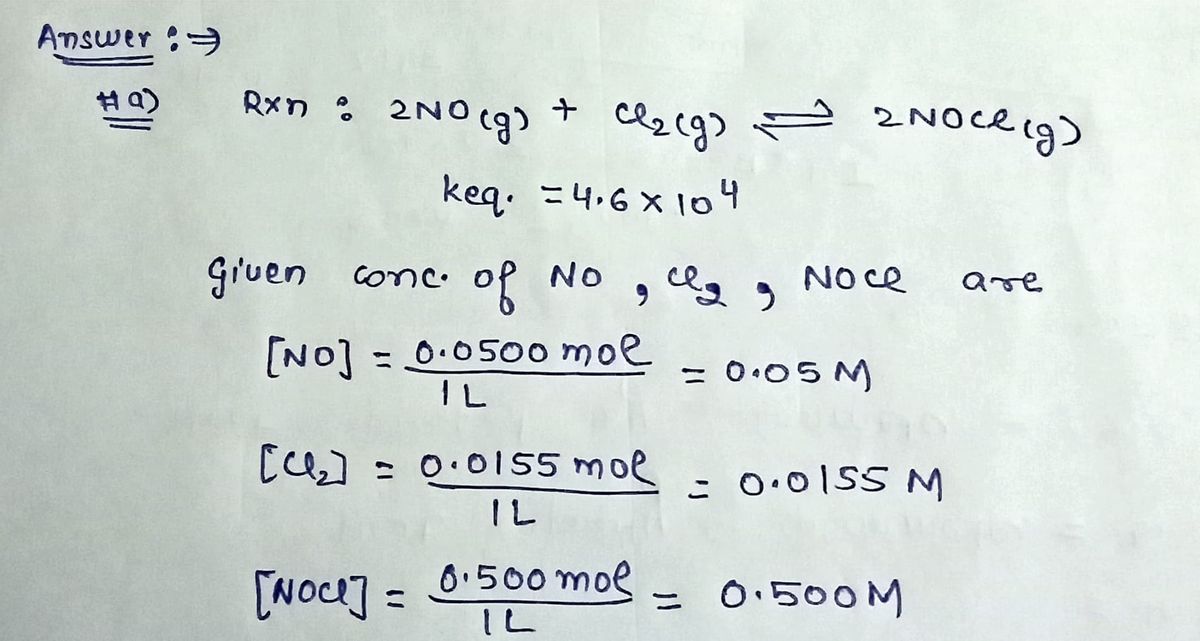3. Determine the reaction quotient and predict the direction that each of the following reactions will proceed to reach equilibrium: a. A 1.00 L flask containing 0.0500 mol NO (g), 0.0155 mol Cl₂ (g), and 0.500 mol NOCI(g): 2NO(g) + Cl₂(g) = 2NOCI(g) = 4.6 × 10¹ A: shift right Keq b. A 5.00 L flask containing 14 g N₂ (g), 12 g H₂ (g), and 17 g NH3(g): N₂(g) + 3H₂(g) = 2NH3(g) Keq = 0.060 (at 526 °C) c. A 2.00 L flask containing 230 g SO3 (8) 2SO3(8)2SO₂(g) + O₂(g) Keg = 0.230 A: shift left A: shift right
3. Determine the reaction quotient and predict the direction that each of the following reactions will proceed to reach equilibrium: a. A 1.00 L flask containing 0.0500 mol NO (g), 0.0155 mol Cl₂ (g), and 0.500 mol NOCI(g): 2NO(g) + Cl₂(g) = 2NOCI(g) = 4.6 × 10¹ A: shift right Keq b. A 5.00 L flask containing 14 g N₂ (g), 12 g H₂ (g), and 17 g NH3(g): N₂(g) + 3H₂(g) = 2NH3(g) Keq = 0.060 (at 526 °C) c. A 2.00 L flask containing 230 g SO3 (8) 2SO3(8)2SO₂(g) + O₂(g) Keg = 0.230 A: shift left A: shift right
Chemistry
10th Edition
ISBN:9781305957404
Author:Steven S. Zumdahl, Susan A. Zumdahl, Donald J. DeCoste
Publisher:Steven S. Zumdahl, Susan A. Zumdahl, Donald J. DeCoste
Chapter1: Chemical Foundations
Section: Chapter Questions
Problem 1RQ: Define and explain the differences between the following terms. a. law and theory b. theory and...
Related questions
Question

Transcribed Image Text:# Reaction Equilibrium Analysis
**Objective:** Determine the reaction quotient and predict the direction that each of the following reactions will proceed to reach equilibrium.
### Reactions and Conditions:
**1. Reaction 1:**
- **Equation:** \( 2 \text{NO}(g) + \text{Cl}_2(g) \rightleftharpoons 2 \text{NOCl}(g) \)
- **Conditions:** A 1.00 L flask containing 0.1500 mol NO, 0.0155 mol Cl\(_2\), and 0.500 mol NOCl.
- **Equilibrium Constant (K\(_{\text{eq}}\)):** \( 4.16 \times 10^{-5} \)
- **Prediction:** Shift right.
**2. Reaction 2:**
- **Equation:** \( \text{N}_2(g) + 3\text{H}_2(g) \rightleftharpoons 2\text{NH}_3(g) \)
- **Conditions:** A 500 L flask containing 14 g N\(_2\), 12 g H\(_2\), and 17 g NH\(_3\).
- **Equilibrium Constant (K\(_{\text{eq}}\)):** 0.060 (at 526°C)
- **Prediction:** Shift left.
**3. Reaction 3:**
- **Equation:** \( 2\text{SO}_2(g) \rightleftharpoons 2\text{SO}_3(g) + \text{O}_2(g) \)
- **Conditions:** A 200 L flask containing 230 g SO\(_3\).
- **Equilibrium Constant (K\(_{\text{eq}}\)):** 0.230
### Prediction:
**General Approach:**
1. **Calculate the Reaction Quotient (Q):** Compare Q to K\(_{\text{eq}}\) to predict the direction of the shift.
2. **Interpret the Shift:**
- If \( Q < K\), the reaction will shift right (toward products).
- If \( Q > K\), the reaction will shift left (toward reactants).
### Conclusion for Reaction 3:
- **Prediction:** The specific shift is not provided; calculate Q and compare with K\(_{\text{eq}}\) to predict the direction.
Use this analysis
Expert Solution
Step 1

Trending now
This is a popular solution!
Step by step
Solved in 4 steps with 4 images

Knowledge Booster
Learn more about
Need a deep-dive on the concept behind this application? Look no further. Learn more about this topic, chemistry and related others by exploring similar questions and additional content below.Recommended textbooks for you

Chemistry
Chemistry
ISBN:
9781305957404
Author:
Steven S. Zumdahl, Susan A. Zumdahl, Donald J. DeCoste
Publisher:
Cengage Learning

Chemistry
Chemistry
ISBN:
9781259911156
Author:
Raymond Chang Dr., Jason Overby Professor
Publisher:
McGraw-Hill Education

Principles of Instrumental Analysis
Chemistry
ISBN:
9781305577213
Author:
Douglas A. Skoog, F. James Holler, Stanley R. Crouch
Publisher:
Cengage Learning

Chemistry
Chemistry
ISBN:
9781305957404
Author:
Steven S. Zumdahl, Susan A. Zumdahl, Donald J. DeCoste
Publisher:
Cengage Learning

Chemistry
Chemistry
ISBN:
9781259911156
Author:
Raymond Chang Dr., Jason Overby Professor
Publisher:
McGraw-Hill Education

Principles of Instrumental Analysis
Chemistry
ISBN:
9781305577213
Author:
Douglas A. Skoog, F. James Holler, Stanley R. Crouch
Publisher:
Cengage Learning

Organic Chemistry
Chemistry
ISBN:
9780078021558
Author:
Janice Gorzynski Smith Dr.
Publisher:
McGraw-Hill Education

Chemistry: Principles and Reactions
Chemistry
ISBN:
9781305079373
Author:
William L. Masterton, Cecile N. Hurley
Publisher:
Cengage Learning

Elementary Principles of Chemical Processes, Bind…
Chemistry
ISBN:
9781118431221
Author:
Richard M. Felder, Ronald W. Rousseau, Lisa G. Bullard
Publisher:
WILEY